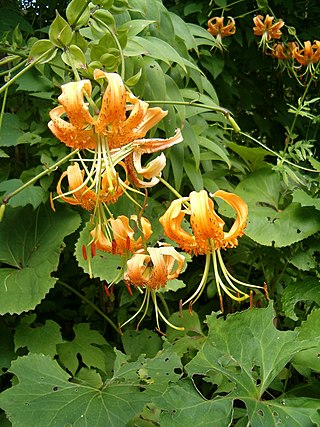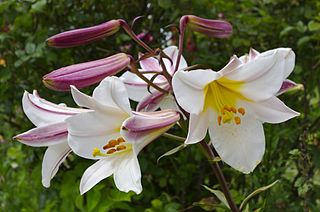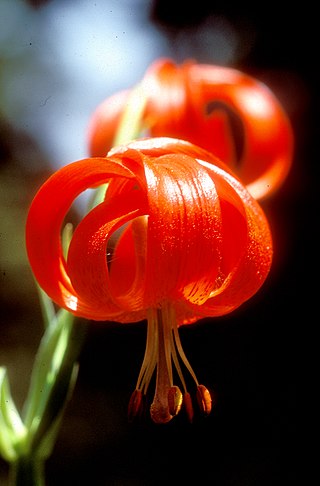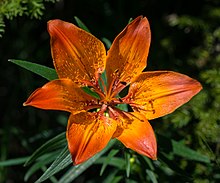
Lilium lancifolium is an Asian species of lily, native to China, Japan, Korea, and the Russian Far East. It is widely planted as an ornamental because of its showy orange-and-black flowers, and sporadically occurs as a garden escapee in North America, particularly the eastern United States including New England, and has made incursions into some southern states such as Georgia.

Lilium is a genus of herbaceous flowering plants growing from bulbs, all with large prominent flowers. They are the true lilies. Lilies are a group of flowering plants which are important in culture and literature in much of the world. Most species are native to the Northern Hemisphere and their range is temperate climates and extends into the subtropics. Many other plants have "lily" in their common names, but do not belong to the same genus and are therefore not true lilies.

Lilium candidum, the Madonna lily or white lily, is a plant in the true lily family. It is native to the Balkans and Middle East, and naturalized in other parts of Europe, including France, Italy, and Ukraine, and in North Africa, the Canary Islands, Mexico, and other regions. It has been cultivated since antiquity, for at least 3,000 years, and has great symbolic value since then for many cultures. It is susceptible to several virus diseases common to lilies, and especially to Botrytis fungus. One technique to avoid problems with viruses is to grow plants from seed instead of bulblets.

Lilium longiflorum, often called the Easter lily, is a species of plant endemic to both Taiwan and Ryukyu Islands (Japan). Lilium formosanum, a closely related species from Taiwan, has been treated as a variety of Easter lily in the past. It is a stem rooting lily, growing up to 1 m high. It bears a number of trumpet shaped, white, fragrant, and outward facing flowers.

Lilium philadelphicum, also known as the wood lily, Philadelphia lily, prairie lily, or western red lily, is a perennial species of lily native to North America.

Lilium martagon, the martagon lily or Turk's cap lily, is a Eurasian species of lily. It has a widespread native region extending from Portugal east through Europe and Asia as far east as Mongolia.

Lilium auratum is one of the true lilies. It is native to Japan and is sometimes called the golden-rayed lily or the goldband lily.

Lilium henryi, sometimes called tiger lily or Henry's lily, is a native lily of the mountains of central China. The flowers are orange, spotted black, and unscented. The petals are recurving, and eventually resemble those of the more widespread Turk's-cap lily.

Lilium speciosum is an East Asian species of plants in the lily family. It is native to southern Japan and southern China, where it can be found at elevations of 600–900 metres (2,000–3,000 ft). It is sometimes called the Japanese lily though there are other species with this common name.

Lilium regale, called the regal lily, royal lily, king's lily, or, in New Zealand, the Christmas lily, is a species of flowering plant in the lily family Liliaceae, with trumpet-shaped flowers. It is native to the western part of Sichuan Province in southwestern China, and cultivated elsewhere as an ornamental. It was introduced to England in 1903 by Ernest Henry Wilson.

Hemerocallis fulva, the orange day-lily, tawny daylily, corn lily, tiger daylily, fulvous daylily, ditch lily or Fourth of July lily, is a species of daylily native to Asia. It is very widely grown as an ornamental plant in temperate climates for its showy flowers and ease of cultivation. It is not a true lily in the genus Lilium, but gets its common name from the superficial similarity of its flowers to Lilium and from the fact that each flower lasts only one day.

A bulbil is a small, young plant that is reproduced vegetatively from axillary buds on the parent plant's stem or in place of a flower on an inflorescence. These young plants are clones of the parent plant that produced them—they have identical genetic material. The formation of bulbils is a form of asexual reproduction, as they can eventually go on to form new stand-alone plants.

Lilium superbum is a species of true lily native to the eastern and central regions of North America. Common names include Turk's cap lily, turban lily, swamp lily, lily royal, or American tiger lily. The native range of the species extends from southern New Hampshire, Massachusetts, and New York, west to Illinois, Missouri, and Arkansas, and south to Georgia, Alabama, Mississippi, and Florida.

Lilium davidii is an Asian species of plants in the lily family, native to mountainous areas of Assam, Manipur, Arunachal Pradesh, Tibet, Bhutan, Hubei, Shaanxi, Sichuan, Guizhou, and Yunnan.

Lilium kelleyanum is a California species of lily known by the common name Kelley's lily. It grows primarily in wetlands in the Sierra Nevada as well as in the Coast Ranges and southern Cascades in the northern part of the state.

Lilium maritimum is a species of lily known by the common name coast lily. It is endemic to California, where it is known only from the coastline north of San Francisco. It formerly occurred south of San Francisco, but these occurrences have all been extirpated. The species is now restricted to the North Coast from Marin County to Del Norte County, and is most common in Mendocino County. It grows in the California coastal prairie habitat, coniferous forests, and bogs amongst Drosera species.

Lilium occidentale is a rare North American species of lily known by the common name western lily. Its species name 'Occidentale' means 'westernmost' and refers to its location along the West Coast. It is native to northwestern California and southwestern Oregon. It grows in coastal prairie habitat, swamps and stagnant bogs with Drosera species, bluffs and sandy cliffs, and seaside spruce forests. This rare wildflower is limited in distribution and directly endangered by a number of environmental factors. It is a federally listed endangered species and it is listed as endangered by the states of California and Oregon.

Lilium parryi, common name lemon lily, is a rare species of lily.

Lilium chalcedonicum is a European species of Liriotypus lily, native to Tuscany, Greece and Albania.

Lilium concolor is a species of flowering plant in the lily family which occurs naturally in China, Japan, Korea and Russia. Its relationship with other species is not clear, although it has some similarities to Lilium pumilum.




















